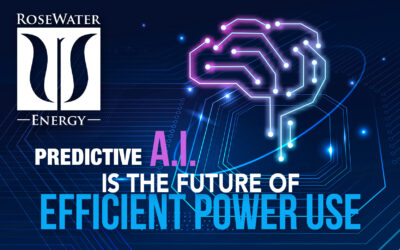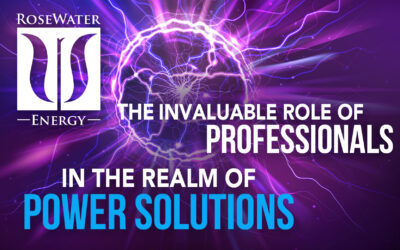Consumers and business owners must ensure their mission-critical devices are protected. That means power quality. Still, good quality won’t mean squat without reliability in that power supply. According to WattLogic CEO Carl Kasalek, “Compromised power is not just an inconvenience. It can be extremely expensive as the lost revenue opportunity can be huge.”
On today’s episode of The Next Generation of Energy, Daniel Litwin continues his discussion with host Joe Piccirilli, CEO of RoseWater Energy, and Carl Kasalek, CEO of WattLogic, to dig into the synergies between power quality and power reliability, and how the two complement each other in the larger ecosystem in managing energy usage and energy supply.
In their first power quality vs. power reliability episode, Litwin, Piccirilli, and Kasalek covered the distinctions between power quality & power reliability, why they matter, and why they matter in practice.
In this continuation of power quality vs. power reliability, Litwin, Piccirilli, and Kasalek discuss the following:
- Consumer and commercial needs in power quality and power reliability.
- The intersection of power quality and power reliability and how they work together.
- How consumer and commercial customers should approach improving power quality.
“People have to consider a power plan for their home and businesses,” Piccirilli said. “And that power plan goes back to what I’m talking about regarding the three circles of protection. What are the mission-critical devices in my home that are microprocessor intensive, whose reliability and performance will be compromised by poor power? And if you don’t know what those devices are, you can go to our website at RoseWater Energy, where we go through that.”
Joe Piccirilli is the CEO and Managing Director of RoseWater Energy. He founded Sound Advice, an upscale HiFi shop that grew to 25 locations. Piccirilli also helped create AVAD, a national distribution company, before founding RoseWater Energy with partners Mario Bottero and Marco Lorenti in 2010.
Carl Kasalek is an accomplished and passionate entrepreneur. Kasalek founded over ten businesses, from 3D printing and energy to contracting and software. Kasalek dedicates his mission to making energy efficiency and EV charging more accessible using innovative software and artificial intelligence. As the founder of WattLogic, Kasalek leads a team focused on developing sustainable energy solutions to meet the needs of a rapidly changing world.
Podcast transcript
Daniel Litwin (00:00):
Hello everyone and welcome to another episode of the Next Generation of Energy, a Rosewater podcast. I’m your host, Daniel Litwin, the voice of B2B. And folks, thanks so much for joining us on another episode of this show. If you’re tuning into this episode, guess what, you’re listening to a part two of two. So if you missed part one, probably take a pause and go listen to the last episode. But this is part two of two, of a conversation we’ve been having with Joe Piccirilli, CEO of Rosewater Energy, as well as Carl Kasalek, CEO of WattLogic, where the two energy industry pros have been discussing the differences and the synergies between power quality and power reliability. Where we left the conversation last was we were about to dig into how the two actually complement each other in the larger ecosystem of managing energy usage and energy supply.
(00:58):
So we’re going to be continuing that conversation here with part two. Make sure you strap in. Make sure you’ve listened in to part one before you continue over the conversation. But if you’re all caught up, then without further ado, let’s get into it. Here are Carl Kasalek, Joe Piccirilli, and myself, Daniel Litwin, the voice of B2B, to guide the rest of the discussion on power quality versus power reliability. We’ve been drawing distinctions, I think very nicely, throughout the podcast between power quality and power reliability, why they matter and why they matter in practice. But I’m curious where they intersect. How do you see power quality intersect with power reliability, and why does power quality matter along with power reliability, excuse me, for both residential and commercial users as a larger ecosystem, treating both with attention and care ends up supporting and impacting the other?
Carl Kasalek (01:54):
I can jump in on that one first. I think that, again, from a consumer mindset, I think one of the most prominent products that people think of when they think of power reliability. Number one, they might think of solar in that way. Well, if I have solar on my home, then I can run my home even when the power becomes disconnected. Almost in all cases that’s not true, unless you have a device that handles that transition for you. No matter how you’re being sold something, that isn’t true unless you’re paying extra effectively for a device that allows you to do that. And got in the industry what we confer is island mode. It will bring your home into an island mode away from the utility. But I think second is a Tesla Powerwall for example. A lot of people now are looking to solutions like the Tesla Powerwall, particularly in places like, I’ll point out, Northern California where they have issues with grid outages and forest fires shutting down entire sections of communities.
(02:53):
And so people look to batteries for reliability. And I think sometimes there’s a false assumption that by installing a Powerwall, you’re going to be able to run your home off that battery for days and probably also assume that that device is going to provide you power quality in the same vein as power passes through it, all the power coming into your home. And I think that’s where there’s an assumption being made that those two intersect each other. And the power wall actually, when it’s running on just pure battery, yeah, will actually clean up some of your power coming off the battery, but it’s not going to filter the power coming in through your utility service and it’s not going to actually have any involvement in that power coming in other than recharging itself. And so I think that’s where we’re starting to see an intersection is that more users are going to renewables, they’re going to batteries, they’re adding electric vehicles, and there’s a lot of assumptions being made that the side benefit of those is that it’s adding power quality.
(03:55):
But I would actually argue the opposite is happening, is that we are straining our grid more and more, and forcing utilities to manage power that they don’t have the understanding of it even entering the grid. So a utility company is very used to producing their own power, knowing exactly what they’re going to produce, when it’s going to be produced and where they’re sending it. When we all add solar on our homes and on our businesses as an example, that power has to go somewhere. So if you’re not using it in your business or your home, it has to feed back onto the grid. The problem there is the utility doesn’t like that, because they don’t know what power is coming to the grid, when it’s coming to the grid. They’re having to manage it, their price is changing, that they’re buying and creating power, and they have to manage all those pathways.
(04:43):
And so there’s a lot of intersections happening, which is the root cause of a lot of these power quality issues that we’re seeing. And so you would assume that all of this technology is actually improving power quality, so it makes a device such as Rosewater less necessary. But I would actually argue the exact opposite is true, is that the more electronics, the more renewables, the more systems that we add to our grid, the more of a problem that we’re creating downstream. And it’s not entirely the utility’s fault. They don’t have a means to keep up with all of this and have their infrastructure manage and account for this. And so it becomes our responsibility as the homeowner or the business owner to make sure that we’re implementing solutions that protect our own systems.
Joe Piccirilli (05:31):
I could not agree more. The problem for the utilities are massive because there is the unpredictability. And it is interesting. I know Carl knows this. Maximum solar harvest is from 10:30 to 1:30 in the afternoon. And unfortunately that’s when a utility needs power the least. So we’re feeding back onto the grid power that the utility has no idea how much, they generally have little to no use for it at that time of day, and they can’t diminish their generation at that point because what if a cloud goes by or what if it’s a cloudy day? Because solar is totally unpredictable. And I think it’s fascinating because again, as Carl pointed out, it is not the utility’s fault. It is a gigantic problem.
(06:23):
It is one of those where, and this is where Carl’s company is, I think starting to do really good work, the use of renewables and batteries is going to be centered around protection of the home, independence of the home. And it’s going to be, in my mind in the future, less around selling it back to the grid at all. And then the system becomes a manageable hybrid. Which is, in my mind, I think where it’s going to go because we’re going to be charging electric vehicles, we’re going to be doing all of these things that are totally unpredictable. Unless you think we can get the world to say it’s four o’clock, you must charge your car at this time. And that’s not going to happen. And they want it at actually 4:00 AM, not PM. So it is interesting at when I’m speaking to clients in our dealer structure, I look at power now as three rings. There is the outer ring, which are things in your house that don’t need battery backup, that don’t need a generator.
(07:33):
They are absolutely non-critical. They don’t need a power quality device. So you leave those off the battery backup and off of the Rosewater. Then there’s a second ring of products that are not microprocessor intensive, but are power intensive. And there a large scale battery backup or a generator works best. And then if you’re using battery backup for that, you should add a renewable to keep those batteries charged because it’s the only way you’re going to do it at long run power outages. And then there is the inner ring, which is your microprocessor intensive products that really hate voltage fluctuations, and that’s where you add the Rosewater type product. And I think that becomes a very well-balanced, well managed home or business. So that’s the way we view it. And the problems are massive. It drives me insane when I hear people, particularly people who are not in our industry, just spow down forever how well, “Yeah, we’re going to renewable energy, solar panels are going to power the world.”
(08:43):
I’m going, “We have to take a step back here and really try to understand the issue.” Because there is a place for all of these technologies and we don’t even know what that place will ultimately be, but there is a place and we should be very careful that we integrate them properly because I would hate to see people get so angry at battery backup and renewables that they stop using them. Because they go, “Oh, this didn’t meet my expectations.” And when I see companies who are rational on their approach and have real technical chops, then I’m going, “Okay, that’s in better hands.” I’m curious, Carl, do you agree with what I’m saying there?
Carl Kasalek (09:32):
I do. Yeah. No, I do. I think at a grander scale that is an assumption that a lot of people have. And I think even from a political landscape, it’s a challenge that many of the commitments that have been made are going to end up being more challenge than I think they really accounted for. And particularly when it comes to renewable transition. You talk about solar being not fully reliable with cloudy days and different things. And wind is a great source of power, but it’s even less reliable in that sense. And so I think there’s a lot of issues and I think that we’re going to start to see at a macro level the dynamics of power shift quite a bit. And that ultimately will hit our pocketbooks as residential users very differently over the next 5 to 10 years as we start to see rates shift.
(10:24):
Not only are they going to rise, but they’re going to shift where we’re used to having cheap power at night. And I think to your point, we’re going to have an abundance of power during the day that many of them will reach points where they’re just wanting to give power away during the day and charge your electric vehicle for free at work. And we’re going to bear the cost in the other sides. And all of that invariability just relates to exactly what we’re talking about right now, related to power quality at a much more macro level.
Joe Piccirilli (10:51):
Yeah, I think what I look forward to, because Daniel, you can correct me if I’m wrong, I think we have talked about the difference between power reliability and power quality. And I’m hoping we’ve created some better understanding out there and I am looking forward to what we’re going to do. I think diving into the renewable battery backup generator, what does it mean? First on the macro level and then on the micro level in the residents, what does that mean? And what are the short-term issues and the long-term issues I think would be really fun for our audience. And obviously there’s some self-serving for me because I think power quality plays a big part in that going forward. But I think this is really good food for thought.
Daniel Litwin (11:42):
And I think this puts us in a good place to wrap up. I really enjoyed taking a backseat as the host today and letting y’all riff. That was my goal was hopefully y’all’s experience would bounce off each other and create some actionable insights for our audience here. But I will get the last word and I’ll toss in a last question for y’all here real quick. Just to end on an actionable note for our audience, how should they approach improving their power quality? Since this is something that the utilities have to deal with on their own front, but really it’s more of an end user challenge for them to engage with improving the power quality of their own residence or commercial building. Since you have to do it on your own, what strategies would you recommend? Where should they start? What’s the first step perhaps that an end user should take to consider improving their power quality? And we’ll end there.
Joe Piccirilli (12:42):
I’ll start on that. I think people now have to consider a power plan for their home, for their businesses. And that power plan goes back to what I’m talking about in terms of the three circles of protection. What are the mission critical devices in my home that are microprocessor intensive whose reliability and performance will be compromised by poor power? And if you don’t know what those devices are, you can go to our website at Rosewater Energy and we go through that. And then what devices during a longer term outage, I don’t want to live without them. I live in South Florida. I do not want to live without my air conditioning. At least one of my air conditioners has to work.
(13:38):
An air conditioner is not a microprocessor intensive device. Unfortunately, the ones that have microprocessors seem to be on separate wiring, which is great, but that is much better served with long-term large battery backup with renewable attached or a generator. And that you have that kind of plan and there are people you can talk to, you can certainly talk to us and some of our dealers to help you do that. But I think that becomes an important part of the consideration now. And the more you ask the question, the more your builders, your contractors will also reach out to experts because they’re going to have to answer it as well. That’s the way I would approach it.
Carl Kasalek (14:22):
Great. And I agree for the residential segment. So I’ll take the commercial industrial segment of that. And I think that the biggest thing I would encourage is informing users that your power bill doesn’t tell the whole story. I think sometimes you look at the line items on your bill and you assume that things are okay. If you’re a large scale industrial user, there’s a thing on your bill called power factor. That can help give you an indication of some problems that you may be facing in your facility and help guide you on a plan to at least dig a little deeper and hunt a little deeper. And we’re seeing a number of users, and it’s a growing list of users, that are actually paying penalties to the utility because their power factor is so off. And the power factor, in a very simple sense, is a representation of the quality of the power in a facility and your efficiency to use that power.
(15:12):
So if you have a low power factor, you’re actually paying for more power effectively than you’re using in your facility. And so there’s a real economic play as well on getting systems in place that help fix that, so that you’re actually getting what you pay for in an industrial facility. And so my biggest piece of advice would be to engage a partner. Many of our customers are Fortune 500 companies that you would think have the engineering teams and that in their company to handle this, and many of them just don’t. Or they’re so busy with everything else they have going on or corporate has thinned down what they’re able to work on and the size of their teams, that this is really where partners can help get involved. And in particular, I’m a little partial obviously to WattLogic, and you can go to wattlogic.com to learn more, but we think we have an outstanding team that can help bring some of those to you.
(16:07):
In particular an industrial setting, we start with some wireless power monitoring devices generally to localize where problems are having, and then go from there. And even if you think you have a facility that’s a machine shop or something that really isn’t microprocessor intense, I would beg to differ nowadays. One of our recent customers that we worked on this exactly with is a large commercial bakery. And actually one of the biggest sources of problems at that bakery was the motors that they used to mix the dough. They were these massive motors and they were causing early failures of all their equipment.
(16:42):
And to them they’re like, “We’re just a baker. We have ovens, we have motors that mix, we throw dough in and product comes out the other side.” They didn’t think about the ramifications on their power factor and on their equipment and failures that they were having, that in some cases would be not only an $80,000 piece of equipment failing, but it would be a million dollars in product loss because that equipment being down shut them down for an entire day until they were able to air in a replacement part. And so I think that’s the shortsighted end of the stick that many people miss. And so I would just really encourage to engage a partner. And I’m happy to be resourced to help just even talk through things and help guide people along the way.
Daniel Litwin (17:20):
I think on that helpful note, we’ll go ahead and wrap up the podcast. Carl, Joe, it has been such a pleasure getting to sit down with both of you today and draw some distinctions, some intersections and highlight the importance of power quality and power reliability. Especially in this age of industrial digitization, but also residential electrification. And digitization as well of various aspects of our day-to-day. As that continues, it’s definitely not slowing down with the rate of smart device adoption, both in the industrial and residential setting.
(18:00):
I think we’re going to have to continue this conversation, which means there might be an opportunity to have you both back on soon. But in the meantime, thank you again to the two of you for your perspectives. Again, folks, as our co-host, we’ve had Carl Kasalek, CEO of WattLogic. And as our guest, Mr. Joe Piccirilli, CEO and managing director of Rosewater Energy. Carl, if folks want to find out a little bit more about your perspective on this topic or maybe get in touch just for you as a partner to pick your brain on some other thought leadership, how can they get ahold of you?
Carl Kasalek (18:30):
Yeah, either going to wattlogic.com. Or my name’s spelled C-A-R-L, and my last name’s K-A-S-A-L-E-K. And you can find me under that on all social media from LinkedIn to Twitter, et cetera.
Daniel Litwin (18:43):
Fantastic. And Joe, same question to you. How can folks get in touch if they want a little more information or where should we point them to further expand their breadth of knowledge around the difference between power quality and power reliability?
Joe Piccirilli (18:55):
Our website is rosewaterenergy.com and there is a tremendous amount of information on there,. Including how to construct a power plan for your house. All of that is on there. Getting ahold of me is also not so difficult on social media. My last name is spelled P-I-C-C-I-R-I-L-L-I. If I’s the only vowel you’re spelling it correctly. First name Joe. And Daniel, I did want to say you started out the podcast saying you weren’t looking for a pat on the back. But here’s your virtual pat on the back. Nice job.
Daniel Litwin (19:29):
Thank you. Hey, I’ll take it. Thank you my friend. But yeah, fantastic. Folks, you heard it there. There’s two websites and two gentlemen here to reach out to with any questions. And we’ll continue to explore this topic here on the podcast, so make sure you’re subscribing. And this has been another episode of the Next Generation of Energy, a Rosewater podcast. Head to rosewaterenergy.com for previous episodes, subscribe on Apple Podcasts and Spotify. And we’ll be back with more expertise, thought leadership, and actionable insights here very soon. I’m your host, Daniel Litwin, the voice of B2B, and we’ll catch you on the next episode.



